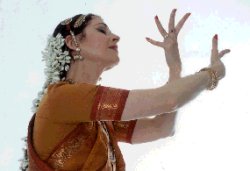 |
 |
Bringing
the dance of the temples to Pittsburgh
|
 |
| Pittsburgh,
Feb 20: The temples of southern India came alive at Carnegie Mellon University
(CMU) here today when Kay Poursine, a disciple of legendary danseuse T
Balasaraswati, performed the Sadir.
“This dance form was codified by the Tanjore Quartet (Ponniah, Chinnaiah, Shivanandam and Vadivelu). It was handed down to my Guru over eight generations and I am dancing exactly the way I learnt it from her,” Poursine told this writer. She initially referred to it as “Bharatanatyam” but later saw that the term encompassed different styles and innovations. While she believes in continuous evolution of the dance, the need for a separate identity for her traditional style led her to employ the term “Sadir”, used before “Bharatanatyam” came in vogue. The presentation was organized by the CMU chapter of the Society for Promotion of Indian Classical Music and Culture among Youth (SPIC MACAY). “The Bharata Natyam recital is structured like a Great Temple: we enter through the gopuram (outer hall) of alarippu...” goes the oft repeated statement of Bala, as near and dear ones knew the veteran dancer, at the Music Academy in 1973 when she was awarded the Sangita Kalanidhi for her contribution to the dance form. Poursine, who trained under Bala between 1973 until her death in 1984, began her performance with “Arunagirinatha”, a Tisram alarippu choreographed by the Ponniah brothers in the early 19th century. “...we cross the ardhamandapam (half-way hall), and enter the holy precinct of the deity in the varnam...” In the Swati Tirunal varnam in Sanskrit, “Dani Samajendra”, composed in the ragam Todi set to Adi talam, the dancer brought to life a woman in the throes of death pleading for one last glimpse of her lover Sri Padmanabha. “...Dancing to the padam is akin to the juncture when the cascading lights of worship are withdrawn and the drumbeats die down to the simple and solemn chanting of sacred verses in the closeness of God...” Two melodious padams followed expressing frustration of two women at different junctures in life. The first, “Teruvil Varano” by Muttutandavar in the ragam Khamas set to the tisra gati Adi talam portrayed a young woman (probably Parvati?????) wondering why Lord Siva let her womanly charms go unnoticed. The second, a moving one in Panthuvarali, “Nittirayil” by Ghanam Krishna Ayyer had an older woman describing a disturbing dream where her man is wooing a younger woman. Poursine then performed a spirited Eka tala javali in Anandabhairavi, “Madura Nagarilo”, with a gopi making halfhearted attempts to thwart Krishna’s flirtatious advances. “...the tillana breaks into movement like the final burning of camphor accompanied by a measure of din and bustle...” The thillana in Adi talam blended beautifully the “din and bustle” of solkettus with the melodious movements of the raga Kapi in which it was composed. “Bala,
in describing dance as a temple experience, was emphasizing on the fact
that the art was not just entertainment but a gradual aesthetic elevation,”
says the ardent disciple of her Guru’s famous words.
Ranjani Rao, a Carnatic music student and enthusiast is a journalist by training. She worked with Indo-Asian News Service, a news agency based in New Delhi, and moved to Pittsburgh after marriage. She works there as an art and culture reporter. |